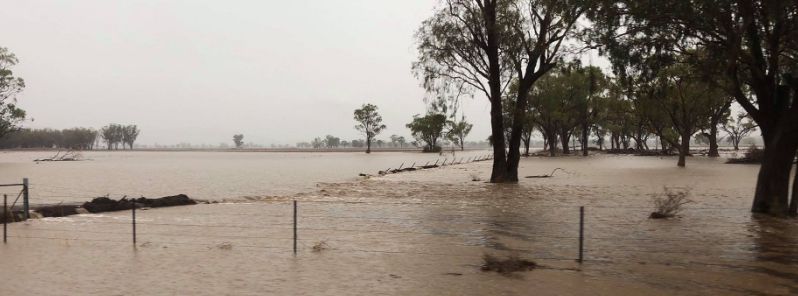Rain dampens fire-hit parts of NSW and Victoria, Australia

Rain fell across parts of New South Wales and Victoria in Australia on Wednesday and Thursday, January 15 and 16, 2020, where dozens of bushfires continue to rage. Meanwhile, severe thunderstorms caused flooding in Melbourne, resulting in a large sinkhole.
NWS's Snowy Valley and south coast, and Victoria's East Gippsland and northeast received 15 mm (0.6 inches) of rain.
As much as 15 mm (0.6 inches) of much-needed rain dampened fire-affected regions of NWS's Snowy Valley and the south coast; and Victoria's East Gippsland and northeast. However, as of January 16, over 80 fires in NSW and 18 in Victoria continue to burn. Moreover, a bolt of lightning ignited two new fires in Great Otway national park.
Despite rains, the NWS Rural Fire Service (NWS RFS) and Victorian County Fire Authority (CFA) said the amount was not enough to put out existing blazes.
"Unfortunately, it had minimal impact in suppressing the fire activity across east and northeast Victoria," said a spokesman for the CFA.
RFS also gave their comment, saying, "Although this rain won't extinguish fires, it will certainly go a long way toward containment."
Roads are blocked, paddocks are lakes and dams are full! #NSW #rain #boggabri #gunnedah @abcnews pic.twitter.com/KBkIAqzw6X
— Dale Drinkwater (@DaleDrinkwater) January 16, 2020
Weather in extremes, heavy smoke on Tuesday, 37 degrees on Wednesday morning and now heavy rain in Melbourne during #AusOpen pic.twitter.com/rRtinwozMz
— Maarten IJzerman (@maartenijzerman) January 15, 2020
A great downpour near Cooma on my way to Bega. I truly hope it also made it to the local fire zones, some more of this needed across the very dry country. #cooma pic.twitter.com/pw1UvseiIy
— Daniel Strickland (@DanStrickAus) January 15, 2020
In Melbourne, 44 mm (1.6 inches) of rain fell at Avalon in just 30 minutes on Wednesday afternoon, while wind gusts reached 110 km/h (68 mph).
As a result of heavy rains overnight, a 15 m (49 feet) deep sinkhole with a diameter of 10 m (33 feet) opened up in the suburbs of Keilor. Essendon SES team said the sinkhole continued to widen when they arrived, and debris was still falling around the edges.
SES has started working with Victoria Police, Melbourne Water, and the City of Moonee Valley to examine and secure the scene.
The crew said they responded to a total of 580 events related to the rains and thunderstorms, with the north and northeast parts being the worst-hit.
St. Albans registered the highest rainfall at 77 mm (3 inches), while Avalon received 49 mm (30 inches) and Keitor 45 mm (28 inches).
Other bushfire-affected areas, unfortunately, did not get as much rain as Melbourne. FOr instance, in the Gippsland region, Mallacoota had no rainfall and Rose Hill near Bairnsdale only had 0.6 mm (0.02 inches).
According to forecasts, up to 50 mm (2 inches) of rain is likely across the NSW south coast into Saturday, January 18, and up to 25 mm (1 inch) in the Snowy Valley and northern Victoria, where fires continue to burn.
Furthermore, the Bureau of Meteorology (BOM) issued thunderstorm warnings for much of NSW, while severe thunderstorm warning has been canceled for Victoria as of January 16.
The 2019-2020 Australian bushfire season has so far resulted in at least 29 fatalities, burned 18.6 million hectares (46 million acres) of land, and destroyed over 5 900 buildings, including around 2 683 homes.
The hit & miss nature of #thunderstorms means it's difficult to forecast exactly where the heaviest rain will be—some parts of #bushfire & #drought affected eastern Australia could see 50–100 mm over the next few days; while others may see very little https://t.co/T7MYuIdxkO pic.twitter.com/zgmiBmqcIG
— Bureau of Meteorology, Australia (@BOM_au) January 15, 2020
#Thunderstorm #warnings in place for much of #NSW and detailed warnings current for parts of the #Illawarra and #Sydney. Heavy burst of rain with thunderstorms. See latest at https://t.co/mobI5N72Fo and radar https://t.co/MSVjVDEbc9 pic.twitter.com/jcteFfpdmv
— Bureau of Meteorology, New South Wales (@BOM_NSW) January 16, 2020
Severe Thunderstorm Warning for #Victoria has been cancelled, with active cells contracting to NSW for now – warnings are still current for this State. You can track storm and shower activity with the BoM radar network: https://t.co/zMO0oK1TwG pic.twitter.com/2NiBVrStZp
— Bureau of Meteorology, Victoria (@BOM_Vic) January 16, 2020
As of 8:30am this morning, 85 bush and grass fires are burning across the state, with 30 to be contained. All fires are at Advice. We are starting to see some good falls across some firegrounds. Lets hope some of our farmers are also getting some moisture. #nswrfs #nswfires pic.twitter.com/JY5BXMZnSh
— NSW RFS (@NSWRFS) January 15, 2020
Relief is here for a number of firefighters working across NSW. Although this rain won’t extinguish all fires, it will certainly go a long way towards containment. This footage was captured down at the Good Good Fire burning near Cooma. #nswrfs #nswfires pic.twitter.com/fxV9u2hN6K
— NSW RFS (@NSWRFS) January 16, 2020
Featured image credit: @DaleDrinkwater/Twitter

Commenting rules and guidelines
We value the thoughts and opinions of our readers and welcome healthy discussions on our website. In order to maintain a respectful and positive community, we ask that all commenters follow these rules.